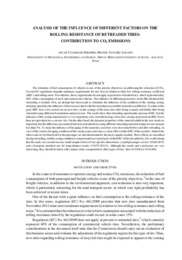Por favor, use este identificador para citar o enlazar este ítem:
https://hdl.handle.net/11000/33431Registro completo de metadatos
| Campo DC | Valor | Lengua/Idioma |
|---|---|---|
| dc.contributor.author | Cuadrado Sempere, Óscar | - |
| dc.contributor.author | Sanchez Lozano, Miguel | - |
| dc.contributor.other | Departamentos de la UMH::Ingeniería Mecánica y Energía | es_ES |
| dc.date.accessioned | 2024-10-07T08:25:17Z | - |
| dc.date.available | 2024-10-07T08:25:17Z | - |
| dc.date.created | 2020 | - |
| dc.identifier.citation | Rubber Chemistry and Technology (2020) 93 (1): 235–260 | es_ES |
| dc.identifier.issn | 1943-4804 | - |
| dc.identifier.issn | 0035-9475 | - |
| dc.identifier.uri | https://hdl.handle.net/11000/33431 | - |
| dc.description.abstract | The reduction of fuel consumption of vehicles is one of the priority objectives in addressing the reduction of CO2. Current EC regulations stipulate minimum requirements for new tires in relation to their low rolling resistance coefficient (RRC) and rolling noise. Nevertheless, these requirements do not apply at present to retreaded tires, which represent today 40% of the consumption of truck and commercial vehicles. The influence of different parameters on the RR obtained after retreading is studied. First, an attempt has been made to eliminate the influence of the condition of the starting casing, studying separately the influence of factors associated with the retread process and the materials used therein. To achieve this goal, RRC tests were carried out on new tires, on the casings of the same tires after being scraped, and finally after being retreaded using different formulations and processes. The results show that retreading significantly increases RRC, but the influence of the casing manufacturer is very important; a tire retreaded using a first-class casing can present an RRC lower than an equivalent low-cost new tire. On the other hand, the dynamic properties of the material added in the new tread are important, but the difference encountered between retreaded tires using different retreading materials and processes remains less than 5%. To study the influence of the aging of the materials, used tires were also tested before and after retreading. In view of the results, the aging condition of the casing seems not to have a clear effect on the RRC of the used tire. Indeed, the effect seems to be beneficial for the passenger car and detrimental for the truck samples studied. Those effects are smoothed during retreading, and the casing condition is not presented as a main factor of the RRC of the retreaded tire. It is worth noting that the study was carried out on a small sample of tires of two specific dimensions: a small passenger car tire (185/65 R15) and a European standard size for long-distance trucks (315/70 R22.5). Although the results and conclusions are very interesting, they should be taken with caution when extrapolated to other types of tires. | es_ES |
| dc.format | application/pdf | es_ES |
| dc.format.extent | 26 | es_ES |
| dc.language.iso | eng | es_ES |
| dc.publisher | American Chemical Society | es_ES |
| dc.rights | info:eu-repo/semantics/openAccess | es_ES |
| dc.rights | Attribution-NonCommercial-NoDerivatives 4.0 Internacional | * |
| dc.rights.uri | http://creativecommons.org/licenses/by-nc-nd/4.0/ | * |
| dc.subject.other | CDU::6 - Ciencias aplicadas::62 - Ingeniería. Tecnología | es_ES |
| dc.title | Analysis of the influence of different factors on the rolling resistance of retreated tires: contribution to CO2 emissions | es_ES |
| dc.type | info:eu-repo/semantics/article | es_ES |
| dc.relation.publisherversion | https://doi.org/10.5254/rct.19.81483 | es_ES |

Ver/Abrir:
RCT_2020-PREPRINT.pdf
1,34 MB
Adobe PDF
Compartir:
 La licencia se describe como: Atribución-NonComercial-NoDerivada 4.0 Internacional.
La licencia se describe como: Atribución-NonComercial-NoDerivada 4.0 Internacional.
.png)